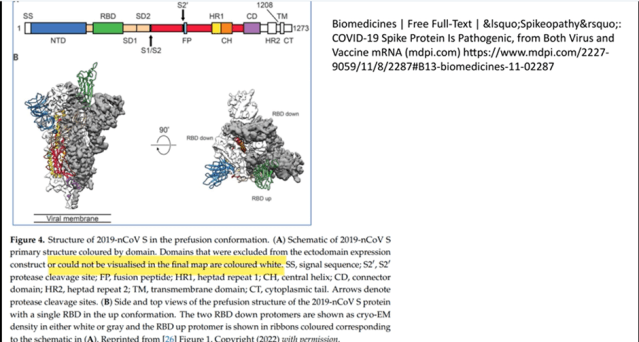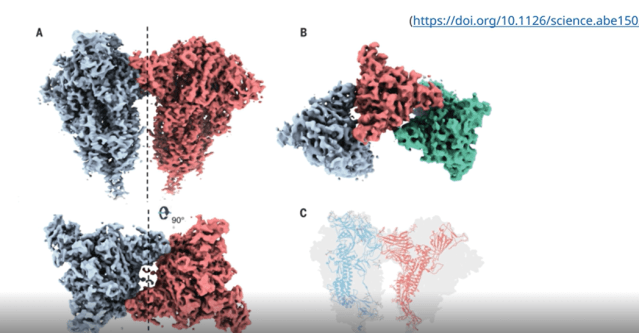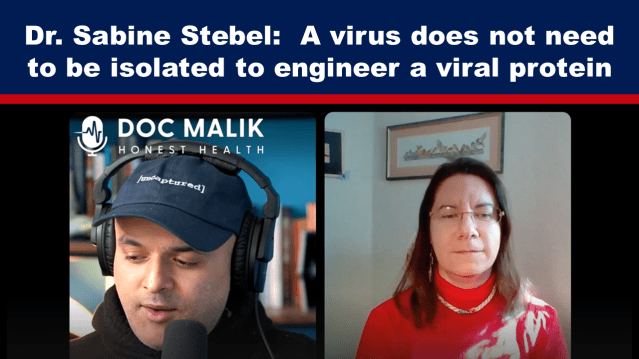Dr. Sabine Stebel: A virus does not need to be isolated to engineer a viral protein
An isolated virus is not needed to engineer a protein. But because the SARS-CoV-2 spike protein is functional, wherever the genetic sequence for it came from, it is not a laboratory experiment mishap – it is by design.
Let’s not lose touch…Your Government and Big Tech are actively trying to censor the information reported by The Exposé to serve their own needs. Subscribe now to make sure you receive the latest uncensored news in your inbox…
Dr. Sabine Stebel is a molecular biologist and expert in protein design. She obtained a PhD from the genetics department of the University of Freiburg in the field of directed protein evolution and DNA fragmentation with method development of nucleotide exchange and excision technology (“NExT”) DNA shuffling. This field is now called protein engineering. Although it is claimed that protein engineering and gain-of-function are distinct concepts in the field of biotechnology, the difference is in the researcher’s intent rather than the process.
Protein engineering is a method used to modify or design proteins to achieve a specific function or property. This is done by manipulating the protein’s sequence, structure, or function to create a new or improved protein. Protein engineering can be used to create proteins with novel functions, enhance existing functions, or improve protein stability and expression.
Gain-of-function research refers to the acquisition of a new or enhanced function by a protein, gene, or organism. This can occur through various mechanisms, including mutations, gene editing, or protein engineering. Gain-of-function can be beneficial, such as in the development of new enzymes or therapeutic proteins, or detrimental, such as in the creation of pathogens with enhanced virulence.
Dr. Stebel has presented her research on protein design, particularly the SARS-CoV-2 spike protein, and has written about covid-related topics on her Substack page ‘DrBine’s Newsletter’. Her expertise in protein engineering and directed evolution is unique and valuable in understanding the molecular biology of covid-19.
At the end of last month, Stebel joined Doc Malik to discuss almost everything you need to know about the spike protein and protein engineering.
If you are unable to watch the video above on Rumble, you can watch it on Doc Malik’s Substack page HERE which also has an option to view the rough transcript.
During the 1 hour and 40-minute interview, Dr. Stebel manages to pack in a lot of information. We have limited this article to the first half hour or so where she explained how proteins, such as the spike protein, are made and whether it came from a virus. At the end of this article, we have shown a rough chapter and timestamp for topics she discussed after the first 30 minutes.
Having completed her PhD in the field of protein engineering, Dr. Stebel knows how proteins are made in a laboratory.
“Before you start to change a protein, you should know how the wild type works and looks like,” she told Doc Malik. “And they didn’t know that [when designing the protein for the covid injections].”
A protein is a 3-dimensional (“3D”) structure. If it is not known what the wild type of, for example, the spike protein of a coronavirus, looks like then it cannot be known if the coronavirus spike protein that is made in the laboratory is the same thing. In a presentation to Doctors for Covid Ethics, Sr. Stebel used a rhinoceros to illustrate this point.
In the image below on the left is an illustration of a rhino drawn from a description (a genetic code) and on the right is a photo of a rhino (an image of the 3D structure). Although the illustrator did a pretty good job, you can see the two are not the same.

The same has happened with the spike protein. Dr. Stebel explained that they modelled the SARS-CoV-2 spike protein from a genetic code without knowing what the wild-type spike protein looked like:
If you look into the Pfizer data batch on this website that Daily Clout uses, you can see they used a protein file, a PDB [Protein Data Bank] file from a database that was released after the trials started.
So, I have no idea how they modelled [the protein] without a 3D structure. They basically work with a DNA sequence but you can’t predict the 3D structure of a protein based on the sequence. This just doesn’t work, not even with deep learning.
(Note: Deep learning is a subfield of machine learning that uses neural networks to teach computers to process data in a way that is inspired by the human brain. It is a method in artificial intelligence (AI) that allows computers to learn from data without being explicitly programmed.)
Dr. Stebel continued:
In principle, we still don’t know what this protein looks like, because what they did was … microscopy, electron microscopy. They had their unsharp images. They modelled a 3D image based on these photos. And then they started to put in the protein sequence so that it matched the photos.
But they don’t know what it looks like inside. So, you need for that – you need crystal structures, X-ray crystal structures.
And we don’t have any.
Was the SARS-CoV-2 Virus Isolated?
Dr. Stebel doesn’t know. I would really like to know what the truth is, she said. And explained why an isolated virus is not needed to develop a viral gene sequence in a laboratory.
In the context of biology, an artefact is an experimental error or a result that is not actually true. The term is generally used for any result that is not actually true but stems from bad analysis or experimental procedures. As Dr. Stebel explained, an artefact doesn’t produce a working protein so the genetic sequence for the spike protein in the covid injections is not an artefact; it is not due to an experimental error or bad laboratory procedures but has been intentionally designed.
You can reassemble pseudogenes from fragments … You can just cut your gene into tiny little fragments, then reassemble these fragments into a gene. It’s called reassembly PCR, very creative. You can cross over different mutants.
But this also happens if you have different fragments of DNA from wherever, and they can just generate pseudogenes. But these pseudogenes wouldn’t lead to working proteins. This would be too much of a coincidence. I don’t think this protein sequence or this DNA sequence is an artefact. Otherwise, you wouldn’t have a working protein that breaks havoc on the body. But we don’t really know where this sequence came from … But I don’t think this gene is an artefact. Otherwise, the protein wouldn’t work.
They definitely made a spike protein, the source of which we don’t know whether there’s a real virus isolated or not. We just know that there was a code. They were given a code.
Directed Protein Evolution and DNA Shuffling
Dr. Stebel was asked whether the sequence could have been designed using gain of function, “where they’ve been playing around with viruses and genetic sequences and have been trying to make things more toxic and dangerous.”
“To optimise a protein, you don’t need the virus,” Dr. Stebel said. “You can just use, for example, phages, which are viruses for bacteria.”
Instead of the normal feed of a phage, you put in the spike protein. And then you can start to mutate it and optimise it and screen it for better binding to ACE2 or whatever without a real dangerous virus.
Then you can take this optimised protein and put it into any virus you want in cell culture. No problem. So, you can screen for optimised proteins on S1 level without any problems. It’s methods from the late 1990s. I did that with my protein. It’s easy. We did that with students in courses.
A bacteriophage, a phage, is a virus which is like a parasite to a bacterium. They only infect bacteria. They only replicate in bacterial cells. They don’t replicate in human cells. And they’re recognised as one of the most abundant biological agents on Earth.
“Normally you take lambda or whatever phage you have in the lab anyway. There are some house animals in the lab you normally use, and there are phage libraries that you can buy from the usual sellers. And then you can just clone in your genes you want to screen with that phage,” Dr. Stebel explained.
You coat some plasticware with a protein of interest, for example, different kinds of ACE2 from different ethnics. Then you have your phage library where you can mutate the feed of the phage with the spike protein via error-prone PCR. You make a PCR of this spike gene and you just add manganese.
[Manganese has been found to increase the error rate in DNA replication, making TAC (DNA polymerase) more error-prone. DNA polymerases are key proteins that catalyse DNA replication and proofread the DNA for any errors as new nucleotides are being incorporated.]
This manganese makes TAC more error-prone; it’s called error-prone PCR. You have lots of single-point mutations in your gene. Then you put the gene back in the phage, and then you can screen if the protein binds better or less to the protein of interest you coated on the plastic wear.
And you do this in some rounds, and then you can gene shuffle – you cut your genes from the library in tiny little pieces, mix them and reassemble them via a reassembly PCR. So, you can get crossover in the test tube and eliminate bad mutations that are detrimental to your protein and accumulate good mutations.
You can do this in a few weeks if the phage is properly set up and displays your protein in the right setup. And then you can do seven to ten rounds of screening in a month. No problem. We did that with students in practical courses with normal libraries we bought to just identify peptides.
But you can do that with proteins. It’s easy. It’s methods from the late 1990s.
Could bacteriophages manufactured with this spike protein, if it was dispersed in some way, cause toxicity and harm to people and cause a pandemic?
Dr. Stebel doesn’t think such a phage would be a problem and wouldn’t cause an epidemic or pandemic. However, “exosomes by the people spiked are a problem because they display the spike protein on their surface. And this could lead to flu-like symptoms,” she said.
Dr. Stebel previously covered the above in more detail during a presentation to Doctors for Covid Ethics. Her presentation covered protein design, particularly the SARS-CoV-2 spike protein, and the mistakes made in constructing this specific protein.
7 February 2024 (23 mins)
If you are unable to watch the video above on Rumble you can watch it on BitChute HERE.
Resources relating to Dr. Stebel’s presentation to Doctors for Covid Ethics:
Moderna and BioNTech Confirm the Virus Was Not Used to Design the Vaccine Spike Protein
Doc Malik recalled Moderna’s CEO Stéphane Bancel saying that he didn’t have the virus and they were designing their vaccine candidates from a computer sequence. “Do you remember hearing that?” he asked Dr. Stebel.
During an interview with Advisory Board in December 2020, Bancel said: “With covid, our team actually designed the vaccine in two days in silico. We never touched the physical virus; we never had a sample of the virus. And we did it in two days.”
It wasn’t only Bancel who confirmed that the covid injection was designed on a computer (in silico) from a genetic sequence, not the virus. BioNTech CEO Uğur Şahin said the same.
“Using the coronavirus’ genetic sequence, which Chinese researchers published on January 11, Sahin designed 10 different candidates on his computer that weekend … Sahin designed that winning candidate in just a few hours,” Business Insider reported in December 2020.
“That’s [also] what Uğur Şahin even writes in his book,” she said. “He downloaded the sequence from a database and worked just with the sequence, and he predicted the 3D structure of the protein based on this DNA sequence, which is impossible. That just doesn’t work.”
There were Olympic games kind of [competition] at my time [in PhD research] where you got the DNA sequence and then you could test your protein structure prediction program against a protein that was crystallised. We knew the structure and could compare how [well our] program could predict the structure of the protein. As far as I know, no one ever got it right.
What Does the Spike Protein Look Like?
What it doesn’t look like is the cartoon-like animations the public was shown by corporate media. Below is a more realistic image of the spike protein.

The white areas in the image of the protein above represent unknown domains. Protein domains are the basic units of proteins that are self-stabilising and fold independently from the rest of the protein chain or structure. Understanding protein domains is essential for understanding the structure and function of proteins, which is crucial for understanding many biological processes and diseases.
“Like white areas on a map, there live dangerous animals or [whatever] they normally write on these maps, there are white areas on the map of the protein,” Dr. Stebel said. Adding, “This was a [Novavax] paper, I don’t know, 2020, 2022. So, we still didn’t know what this protein really looks like with white areas.”
So, no one knows what the SARS-CoV-2 spike protein looks like, she said, and that is still the case now.
It is Not a Trimer Protein as Claimed
In biochemistry, a protein trimer is a macromolecular complex formed by three, usually non-covalently bound, macromolecules like proteins or nucleic acids. It is claimed that the SARS-CoV-2 spike protein is a trimeric protein that plays a crucial role in the virus’s life cycle. The trimeric protein consists of three copies of the spike glycoprotein with two regions known as S1 and S2. The S1 subunit is responsible for receptor binding and the S2 subunit is responsible for membrane fusion.
“The funny thing is they always talk about a trimeric protein, yeah? But this thing makes hexamers and monomers,” Dr. Stebel told Doc Malik.
Monomers can react together with other monomer molecules to form a larger polymer chain or three-dimensional network in a process called polymerisation. As such, monomers are the building blocks of polymers, very large molecules linked together into chains of repeating subunits.
A hexamer is a polymer formed from six molecules of a monomer. In the context of molecular biology, a hexamer is a structural subunit that is part of a viral capsid and is itself composed of six subunits of similar shape and size.
The image below is of a trimer. “A trimer can bind to another trimer and to yet another trimer,” Dr. Stebel explained.
“So [as seen in the image below] you have three trimers bound to each other. [The image is] from the Novavax paper. Okay, so when you say trimer, you mean the protein has three parts to it, yeah? Three subunits. And the three subunits can actually link to create six subunits and a nine-subunit conglomerate,” she said.
Which means it is not a trimer but a hexamer or a polymer. “And that’s from the Novavax paper from 2020, so they knew that,” Dr. Stebel said. In other words they have lied to us, yet again.

Chapter and timestamps for the remainder of Dr. Stebel’s interview with Doc Malik
- 30:58 Are spike proteins always locked onto the cell surface or can they break off into the bloodstream?
- 33:54 How much spike protein does the body produce?
- 35:13 Are spike proteins responsible for the intravascular clots?
- 39:13 In 2020, Stebel was working for a company that processed PCR tests. She quit because the method they were using was unscientific. She explained why. She now writes expert opinions for lawyers on the mechanisms of harm from medicinal products.
- 45:52 What harm can the spike protein cause?
- 47:28 What can people who have had covid injections do to minimise the risk or downplay the action of the spike protein and stop it from producing?
- 53:56 What are the issues with the lipid nanoparticles in the covid injections?
- 1:00:01 Were the vaccines simply people making mistakes or was it deliberate harm and criminality?
- 1:06:40 BioNTech began engineering the protein for its vaccines in January/February 2020 before the covid pandemic had been declared.
- 1:13:52 If you have been vaccinated are you a genetically modified human being?
- 1:16:09 What is driving the people developing and marketing mRNA products?
- 1:17:48 Did certain “elites” receive saline solutions instead of a covid vaccine?
- 1:19:48 What advice would you give?




